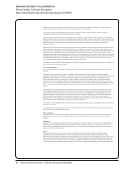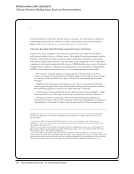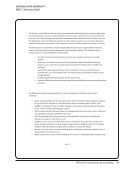SPEC Kit 337: Print Retention Decision Making · 87
UNIVERSITY OF MASSACHUSETTS AMHERST
Strategy for Deaccessioning Books and Serials
Strategy for Deaccessioning Books and Serials
The imperative to reduce the collection footprint is something many research libraries
now face. The Libraries’ collection space has exceeded the recognized 80% working
capacity for over 10 years. We have been able to manage this through the ability to send
materials, primarily serials and journals, to the Five College Libraries Depository
(FCLD). However, space at the FCLD is at near capacity. Discussions are underway on
how best to expand that facility but a solution is still several years away.
The forthcoming Du Bois Library electrical upgrade is scheduled to begin in July, 2012.
It will have a significant impact on existing stack space. A minimal impact design now
under consideration would require the removal of 8-12 sections per stack floor, possibly
25,000 volumes. There also is the potential now or in the future that the space required to
renovate two existing electrical closets on each Du Bois floor will translate into an
overall decrease in collection space of approximately 125,000 volumes. In either case,
the impact is significant and the time frame pressing. Why the large impact? It is due
primarily to building code changes in the past 35 years.
The Libraries’ Master Plan for the Du Bois Library and the Science and Engineering
Library proposes to repurpose library space to anticipate changing user needs, The
Libraries must develop a coherent strategy for de-accessioning print materials to deal
proactively with the electrical upgrade for near term and to meet changing service needs
in the longer term.
We have developed strategic partnerships with the Four Colleges and the Boston Library
Consortium to develop a systematic approach to withdrawing duplicate materials that are
held elsewhere in these consortia, and to ensure continued access to materials for faculty
and staff served by those member libraries. Other groups that have well-established
models for withdrawing duplicate print materials include:
• Print Archive Network (PAN): The Center for Research Libraries was
instrumental in creating PAN. PAN was designed as a prototype national print
archives network, and builds on the overlap among currently active archives for
JSTOR, the American Chemical Society, the American Physical Society, and the
American Institute of Physics. It now has expanded to include other journals, and
is intended to assign responsibility for material retention. The Five College
Libraries are involved in ongoing discussions with PAN about the creation of a
national network of print repositories.
• Orbis Cascade, a consortium in the Northwest, has taken an approach similar to
PAN for creating a print archive of widely owned print journal backfiles. They
recently merged with WEST (the Western Regional Storage Trust) to plan for a
UNIVERSITY OF MASSACHUSETTS
AMHERST
UMASS AMHERST LIBRARIES
University of Massachusetts
154 Hicks Way
Amherst, MA 01003-9275
Hicks Way
UNIVERSITY OF MASSACHUSETTS AMHERST
Strategy for Deaccessioning Books and Serials
Strategy for Deaccessioning Books and Serials
The imperative to reduce the collection footprint is something many research libraries
now face. The Libraries’ collection space has exceeded the recognized 80% working
capacity for over 10 years. We have been able to manage this through the ability to send
materials, primarily serials and journals, to the Five College Libraries Depository
(FCLD). However, space at the FCLD is at near capacity. Discussions are underway on
how best to expand that facility but a solution is still several years away.
The forthcoming Du Bois Library electrical upgrade is scheduled to begin in July, 2012.
It will have a significant impact on existing stack space. A minimal impact design now
under consideration would require the removal of 8-12 sections per stack floor, possibly
25,000 volumes. There also is the potential now or in the future that the space required to
renovate two existing electrical closets on each Du Bois floor will translate into an
overall decrease in collection space of approximately 125,000 volumes. In either case,
the impact is significant and the time frame pressing. Why the large impact? It is due
primarily to building code changes in the past 35 years.
The Libraries’ Master Plan for the Du Bois Library and the Science and Engineering
Library proposes to repurpose library space to anticipate changing user needs, The
Libraries must develop a coherent strategy for de-accessioning print materials to deal
proactively with the electrical upgrade for near term and to meet changing service needs
in the longer term.
We have developed strategic partnerships with the Four Colleges and the Boston Library
Consortium to develop a systematic approach to withdrawing duplicate materials that are
held elsewhere in these consortia, and to ensure continued access to materials for faculty
and staff served by those member libraries. Other groups that have well-established
models for withdrawing duplicate print materials include:
• Print Archive Network (PAN): The Center for Research Libraries was
instrumental in creating PAN. PAN was designed as a prototype national print
archives network, and builds on the overlap among currently active archives for
JSTOR, the American Chemical Society, the American Physical Society, and the
American Institute of Physics. It now has expanded to include other journals, and
is intended to assign responsibility for material retention. The Five College
Libraries are involved in ongoing discussions with PAN about the creation of a
national network of print repositories.
• Orbis Cascade, a consortium in the Northwest, has taken an approach similar to
PAN for creating a print archive of widely owned print journal backfiles. They
recently merged with WEST (the Western Regional Storage Trust) to plan for a
UNIVERSITY OF MASSACHUSETTS
AMHERST
UMASS AMHERST LIBRARIES
University of Massachusetts
154 Hicks Way
Amherst, MA 01003-9275
Hicks Way


















































































































































































































